1. Introduction
How to understand the relation between knowledge and action has been a long-standing question in philosophy. In addition to their famous divergence of a prior knowledge, Descartes and Locke hold differing views on the relation between knowledge and action. More specifically, the dispute centers on whether the standard of knowledge, or the requirement for knowing, and the standard of corresponding actions, or the epistemic requirement for doing, are independent of each other (Turri and Buckwalter Reference Turri and Buckwalter2017).
As to Descartes, the standards for knowledge and action are fundamentally separated. In his discussion of skepticism, Descartes clarifies that he is concentrating on knowledge, not action (Descartes Reference Descartes1986). He also emphasizes that his pure inquiry into knowledge should be distinct from the requirement for action guidance in daily life. Descartes' view of the relation between knowledge and action is a clear example of the perspective on knowledge known as purism or intellectualism, which insists that knowledge should be determined only by truth-relevant factors like belief, evidence, and reliability. According to this understanding, the standard of knowledge and action cannot be the same, as the latter must consider practical concerns while the former does not.
In contrast, Locke presents a different view. In his An Essay Concerning Human Understanding (Reference Locke1983), Locke maintains that knowledge need not be completely free of doubt as long as it is adequate for action. This suggests a much more intimate relation between knowledge and action. Contemporary pragmatic encroachment versions of Locke's view hold that whether someone knows something is at least partially determined by practical factors such as stakes and urgency. Some pragmatic encroachers even argue that knowledge serves as the sufficient and necessary epistemic condition for action (Fantl and McGrath Reference Fantl and McGrath2007; Hawthorne and Stanley Reference Hawthorne and Stanley2008), therefore the standard of knowledge will vary as practical considerations change.
This debate received relatively little attention since purism has long been considered the default position in epistemology and widely accepted as orthodox. However, some new disputations on the relation between knowledge and action have recently surged under the discussion of some knowledge attribution cases. These cases suggest that the truth value of knowledge attribution claims, such as “S knows p,” are sensitive to practical factors such as stakes. And pragmatic encroachers find these cases supportive of their theory since these cases can be well explained based on their proposal about the relation between knowledge and action.
However, while introducing new resources to this issue, recent studies from experimental philosophy on these knowledge attribution cases also complicate the disputation. On the one hand, experiments have not consistently found influences of stakes on judgments about knowledge (Buckwalter Reference Buckwalter2010; Feltz and Zarpentine Reference Feltz and Zarpentine2010; Pinillos Reference Pinillos, Brown and Gerken2012; Pinillos and Simpson Reference Pinillos, Simpson and Beebe2014; Rose et al. Reference Rose, Machery, Stich, Alai, Angelucci, Berniūnas, Buchtel, Chatterjee, Cheon, Cho, Cohnitz, Cova, Dranseika, Lagos, Ghadakpour, Grinberg, Hannikainen, Hashimoto, Horowitz, Hristova, Jraissati, Kadreva, Karasawa, Kim, Kim, Lee, Mauro, Mizumoto, Moruzzi, Olivola, Ornelas, Osimani, Romero, Rosas Lopez, Sangoi, Sereni, Songhorian, Sousa, Struchiner, Tripodi, Usui, Vázquez del Mercado, Volpe, Vosgerichian, Zhang and Zhu2019; Sripada and Stanley Reference Sripada and Stanley2012). On the other, even when significant effects of stakes on knowledge judgments are observed (Pinillos Reference Pinillos, Brown and Gerken2012; Pinillos and Simpson Reference Pinillos, Simpson and Beebe2014; Sripada and Stanley Reference Sripada and Stanley2012), it is hard to tell whether pragmatic encroachment offers the best explanation.
Since empirical studies so far have not yet been able to give definitive support to either purism or pragmatic encroachment, this study conducted three new experiments to explore folks' views about the relation between knowledge and action. The experiments adopted three pairs of classic knowledge attribution cases, and two of the experiments involved concurrent judgments on knowledge and action. The results reveal that the judgments about knowledge are not co-variant with stakes as pragmatic encroachment once expected. These findings suggest a tendency among ordinary people toward some form of purism and imply a conversational implicature explanation of the relation between knowledge and action.
This paper starts by examining the recent controversy around the relation between knowledge and action raised by the discussion on knowledge attribution cases. Within this context, it addresses two core concerns that empirical studies so far cannot provide definitive answers. Subsequently, it reports three experiments based on three pairs of classic knowledge attribution cases on Chinese participants, which aimed at illuminating ordinary people's views about the relation between knowledge and action. Afterward, it argues that, if the experimental results prove reliable, it is reasonable to infer that ordinary people are more prone to be purists.
2. The debate around knowledge attribution cases
The recent surge of interest in the traditional debate on the relation between knowledge and action emerged under the discussion of some knowledge attribution cases. These cases were initially proposed to defend epistemic contextualism (EC), roughly the view that the truth conditions of knowledge attributing sentences like “S knows that p” are sensitive to context. Proponents of EC claim that intuitions supporting this sensitivity can be strongly triggered by pairs of cases such as the following (DeRose Reference DeRose1992: 913):
Bank Case A. My wife and I driving home on a Friday afternoon. We plan to stop at the bank on the way home to deposit our paychecks. But as we drive past the bank, we notice that the lines inside are very long, as they often are on Friday afternoons. Although we generally like to deposit our paychecks as soon as possible, it is not especially important in this case that they be deposited right away, so I suggest that we drive straight home and deposit our paychecks on Saturday morning. My wife says, “Maybe the bank won't be open tomorrow. Lots of banks are closed on Saturdays.”I reply, “No, I know it'll be open. I was just there two weeks ago on Saturday. It's open until noon.”
Bank Case B. My wife and I drive past the bank on a Friday afternoon, as in Case A, and notice the long lines. I again suggest that we deposit our paychecks on Saturday morning, explaining that I was at the bank on Saturday morning only two weeks ago and discovered that it was open until noon. But in this case, we have just written a very large and very important check. If our paychecks are not deposited into our checking account before Monday morning, the important check we wrote will bounce, leaving us in a very bad situation. And, of course, the bank is not open on Sunday. My wife reminds me of these facts. She then says, “Banks do change their hours. Do you know the bank will open tomorrow?” Remaining as confident as I was before that the bank will be open then, still, I reply, “Well, no. I'd better go in and make sure.”
Although the protagonist makes opposing claims about whether he knows the bank will open on Saturday in Bank cases A and B, both claims seem true. As to EC, this is
due to the differing truth conditions of knowledge attribution sentences in these two cases. Contextual factors such as stakes raise the standard for truly claiming that ‘I know the bank will be open tomorrow’ in Bank case B. Therefore, as the protagonist's epistemic position remains constant, the knowledge claim in Bank case A is no longer true in Bank case B.
Epistemic contextualists consider this flexibility of knowledge attribution claims in different contexts as support from the ordinary language for their theory. However, EC may not be the only interpretation of the opposing claims in these cases. Pragmatic encroachers claim they can provide a better explanation based on their proposal about the relation between knowledge and action. And they also take the explanatory power of pragmatic encroachment to these cases as a motivation for their approach (Schroeder Reference Schroeder2012), as well as an advantage over purism.
According to pragmatic encroachment, there should be a parallel between the judgment about knowledge and the judgment about the corresponding action. Specifically, they hold that S knows that p if and only if S is rational to act as if p (Fantl and McGrath Reference Fantl and McGrath2007). Given the same epistemic position of the protagonist in both cases, it is rational for him to go straight home without verifying the bank's Saturday opening in Bank case A, while irrational in Bank case B, considering the possible loss of error. Therefore, the protagonist knows that ‘the bank is open on Saturday’ in Bank case A but not in Bank case B (Stanley Reference Stanley2005). This explanatory framework for knowledge attribution cases is also known as Subject-Sensitive Invariantism (SSI).
It is noteworthy that although pragmatic encroachers utilize those knowledge attribution cases raised by EC, they have no interest in the truth value of the knowledge attribution sentences. Their focus centers on whether the protagonists when facing various practical factors have knowledge or not, instead of whether specific knowledge attribution claims in different contexts are true or false. Based on those cases, pragmatic encroachers argue that practical factors such as stakes can make a difference in determining whether someone knows something. And this phenomenon can serve as a support since it can be best explained by appealing to the close relation between knowledge and action that the pragmatic encroachment favors.
Purists of course deny the necessity to take a pragmatic encroachment view about knowledge to explain the opposing claims in those knowledge attribution cases. Some of them just turned to certain versions of EC,Footnote 1 while others proposed some purist invariantism accounts. For example, Nagel argues that the protagonist in Bank case B does not have an outright belief as the protagonist in Bank case A does, therefore is in a distinct epistemic position (Reference Nagel2011). And Brown points out that the protagonist refrains from claiming knowledge in Bank case B due to impropriety rather than falsehood, since such a claim could pragmatically transmit misleading information (Reference Brown2006).
Considering that both purism and pragmatic encroachment appeal a lot to our common understanding of the relation between knowledge and action in their defense,Footnote 2 indicating their ambition in accommodating folk's views about knowledge, there is no wonder that their dispute extends to the interpretation of the data from ordinary people. However, according to studies up to now, it remains hard to tell which side better captures the folk's understanding of knowledge, since they cannot provide definitive answers to two core concerns. The first is whether ordinary people's standards of knowledge are sensitive to stakes. And the second is whether pragmatic encroachment is the sole or best explanation for this sensitivity.
As to the first concern, the influence of stakes on knowledge attribution has yielded mixed results in experimental studies. The first wave of experimental research on knowledge attribution cases emerged around 2010 (Buckwalter Reference Buckwalter2010; Feltz and Zarpentine Reference Feltz and Zarpentine2010). In these experiments, participants were asked to read some scenarios, such as the above Bank cases, and then decide if they were willing to attribute knowledge to the protagonists. Studies with this traditional paradigm generally find no significant difference in participants' inclination to knowledge attribution between high-stake and low-stake cases. And these null outcomes were widely replicated with diverse materials and global participants (Rose et al. Reference Rose, Machery, Stich, Alai, Angelucci, Berniūnas, Buchtel, Chatterjee, Cheon, Cho, Cohnitz, Cova, Dranseika, Lagos, Ghadakpour, Grinberg, Hannikainen, Hashimoto, Horowitz, Hristova, Jraissati, Kadreva, Karasawa, Kim, Kim, Lee, Mauro, Mizumoto, Moruzzi, Olivola, Ornelas, Osimani, Romero, Rosas Lopez, Sangoi, Sereni, Songhorian, Sousa, Struchiner, Tripodi, Usui, Vázquez del Mercado, Volpe, Vosgerichian, Zhang and Zhu2019; Sripada and Stanley Reference Sripada and Stanley2012). However, experiments with the ‘evidence-seeking’ paradigm yielded positive results (Pinillos Reference Pinillos, Brown and Gerken2012; Pinillos and Simpson Reference Pinillos, Simpson and Beebe2014; Sripada and Stanley Reference Sripada and Stanley2012). Different from the experiments of the first wave, the “evidence-seeking” paradigm asked participants to assess the amount of effort protagonists needed to devote before being counted as knowing, instead of determining whether the protagonists in certain cases had knowledge. It turned out that participants agreed that the protagonists needed to seek more evidence to be deemed as knowing when facing higher stakes.
As to the second, there are disagreements on how to interpret the findings from the “evidence-seeking” paradigm. Pragmatic encroachers claim that these results illustrate variations in ordinary people's knowledge judgments contingent upon practical issues, therefore supporting their proposal. Nevertheless, purists contend that those positive results may stem from how questions were framed in the experiments. Questions about the extra effort required for knowledge can be confused with questions about the extra effort required for related actions (Gerken Reference Gerken2017). According to a recent study, participants often took the “evidence-seeking” prompt as soliciting predictions about what the protagonists “would” or “will” do, rather than specifying conditions for knowledge (Hansen et al. Reference Hansen, Francis and Greeningforthcoming). If that is the case, findings from the “evidence-seeking” paradigm should be explained as the sensitivity of judgments about action to stakes, rather than the sensitivity of judgments about knowledge to stakes. And the sensitivity of judgments about action to stakes is compatible with purism.
The importance of these two concerns is easy to see. For the first concern, if ordinary people's judgments about knowledge remain consistent across cases with different stakes, the need for pragmatic encroachment to provide an explanation will diminish, rendering its advantage in accounting for these cases pointless. For the second concern, even ordinary people's judgments about knowledge are affected by stakes sometimes, if it can be well explained or even better explained by purism, pragmatic encroachment will gain no advantage from the disputation around those knowledge attribution cases.
To solve the debate between purism and pragmatic encroachment around knowledge attribution cases, I ran three experiments that can help respond to the two concerns. In two of the experiments, participants were asked to make judgments about knowledge and action at the same time. On the one hand, this can isolate the influence of stakes on judgments about knowledge and action, avoiding the confusion that may arise in the “evidence-seeking” paradigm. On the other, this can directly examine if judgments about knowledge and action exhibit a parallel pattern as pragmatic encroachers expect. The third experiment was conducted to further determine which side better accounted for the results of the previous two experiments.
It turned out that stakes failed to change the standard for knowledge attribution. Meanwhile, since participants' judgments about action showed much greater sensitivity to stakes than judgments about knowledge, pragmatic encroachment can hardly explain the influence of stakes on knowledge attribution in certain cases, for its explanation appeals to the co-variation between judgments about knowledge and judgments about action. Moreover, this divergence in judgments about knowledge and action implies a purism view on the relation between knowledge and action among ordinary people.
3. Experiment 1
This experiment was conducted for two purposes. Firstly, it aims to detect whether practical factors, particularly stakes, can raise ordinary people's standard of knowledge attribution. Secondly, it seeks to explore if ordinary people hold a pragmatic encroachment view of the relation between knowledge and action, whereby S knows that p if and only if S is rational to act as if p. During the experiments, participants were asked to judge whether the protagonist had certain knowledge and whether the protagonist needed further information for relevant actions at the same time. This would help determine the impact of stakes on knowledge and action judgments respectively, as well as observe the relation between the two kinds of judgments.
3.1. Participants
Four hundred twenty-five questionnaires were collected in total, and 272 were deemed effective, with a retrial rate of 64.0% (26.8% were excluded due to incorrect responses to comprehension questions, and 9.2% were excluded due to their possession of at least one degree in philosophy).Footnote 3 The effective sample ranged from 18 to 58 years old (M = 29.69, SD = 7.16), with females comprising 59.6%. The experiments were conducted via the online survey platform Wenjuanxing (http://www.wjx.cn), with all materials delivered in Chinese. The questionnaire took an average of 2.5 minutes to complete. Repeat participation was prevented through IP. A comprehensive dataset is accessible in supplementary materials provided on CJO.
3.2. Materials and design
The materials were adopted from three pairs of classic knowledge attribution cases: DeRose's Bank cases, Cohen's Airport cases, and Pinillos's Spelling cases. Considering the extensive variations derived from these three pairs of classic cases, which have been widely discussed in literature and used in prior experiments, this study decided not to stick to any specific version. Instead, it retained the main structure while introducing certain modifications to better serve the experiment's purpose and ensure their mutual parallelism.
For example, some versions of the knowledge attribution cases involve protagonists making explicit knowledge claims like “I know the bank will be open tomorrow” within the narrative. However, since the purpose of the study is to figure out ordinary people's standard of knowledge, rather than their opinion about the truth conditions of knowledge attribution sentences, such claims were removed. Instead, participants were directly prompted to decide whether the protagonists had knowledge. Moreover, the experiment deliberately retained the Western names of the protagonists and places in the scenarios. Given substantial disparities in bank opening hours, organ transplantation policy, and scholarship systems between China and Western countries, Western names would make the scenarios more sensible to Chinese participants. And their judgments would be more likely to depend on the information given in the material instead of their personal experience, such as banks are always open on Saturdays in China (see supplementary materials provided on CJO for the original material in Chinese and their translated version in English).
The experiments employed a between-subjects design, with participants randomly divided into six groups with different conditions (stories × high or low stakes 3 × 2, see Table 1). The story variable was considered a random factor, which aimed to prevent judgments from being unduly caused by some irrelevant details of certain scenarios.
Table 1. The block design of the experiment

Each participant was required to read only one scenario and respond to some related questions. In high-stake conditions, the protagonists hold beliefs with potentially disastrous consequences if incorrect, while in low-stake conditions, the protagonists hold beliefs inconsequential in terms of its truth. Taking the Bank cases for example, the differences between high and low stake conditions are as follows:
Today is Friday, and it's the payday of the restaurant where John works. Because the salary at this restaurant is paid in cash, John intends to deposit this money in the bank after work. However, when he arrives at the bank, he finds that the bank is packed with people waiting in line…
[low stake] …Although John is used to depositing his salary in the bank as quickly as feasible, this money does not require to be deposited these days. For him, it makes no difference to deposit it early or later. In addition, he knows that the bank is closed on Sundays.
[high stake] …John's rent is automatically transferred to his landlord by his bank every month. If he fails to deposit this money in the bank by Monday, his rent will not be paid on time due to insufficient funds in his account. His landlord is very strict. If he does not pay the rent on time, he will be evicted immediately. It's very important for John to deposit this money in the bank by Monday. In addition, he knows that the bank is closed on Sundays.
…Because there are so many people waiting in the bank, John decides to go home and deposit money the following tomorrow (Saturday) morning. Many banks are closed on Saturdays, but John remembers that he came to the bank on a Saturday morning half a year ago and found it open. John believes the bank is open on Saturday.
In the Airport cases, the protagonist is an organ courier. In the high-stake case, he needs to transport a liver to Chicago, and a direct flight is necessary to prevent organ spoilage. Conversely, in the low-stake case, the protagonist is on vacation and plans to fly to Chicago for a basketball game. He will miss the game if the fight is indirect, but it won't matter to him.Footnote 4 In the Spelling cases, the protagonist is a student with coursework due the next day. In the high-stake case, any typo in his coursework could lead him to get expelled from school. While in the low-stake case, typos in his coursework bear no consequence or significance.
After reading the material, participants were asked to choose the best description of the protagonist's situation from the following four options:
A. John knows the bank is open on Saturday. It is necessary for John to check the opening hour of the bank before going home.Footnote 5
B. John knows the bank is open on Saturday. It is not necessary for John to check the opening hour of the bank before going home.
C. John does not know the bank is open on Saturday. It is necessary for John to check the opening hour of the bank before going home.
D. John does not know the bank is open on Saturday. It is not necessary for John to check the opening hour of the bank before going home.
It is assumed that if participants agree with the pragmatic encroachment, options B and C will be their only acceptable options. And option B should be the dominating response in the low-stake cases, and option C should be the dominating response in the high-stake cases. On the contrary, if participants stand with purism, they will also be willing to choose options A and D in some situations.
Then participants needed to answer a comprehension question about some details in the scenario they had just read, to confirm their awareness of the manipulated factors in the context. The inclusion of such questions serves a dual purpose: ensuring participants' engagement and preventing null results due to manipulation failure. For example, in the Bank cases, participants were asked:
When should John deposit the money in the bank?
A. Before next Monday.
B. Anytime will be fine
C. Before next Wednesday.
D. Before next Friday.
Since the comprehension questions were tied to the protagonist's stakes in the scenarios, participants who failed to answer these questions were excluded for their potential ignorance of the information about the stakes.
3.3. Result
3.3.1. Stake-effects on four response options
Participants' choices of the four response options showed different patterns between low-stake and high-stake conditions. The percentages of the four response options across the three pairs of cases are presented in Figure 1. (Low-stake: A: 36.8%, B: 38.9%, C: 16%, D: 8.3%; High-stake: A: 52.3%, B: 25.8%, C: 20.3%, D: 1.6%):
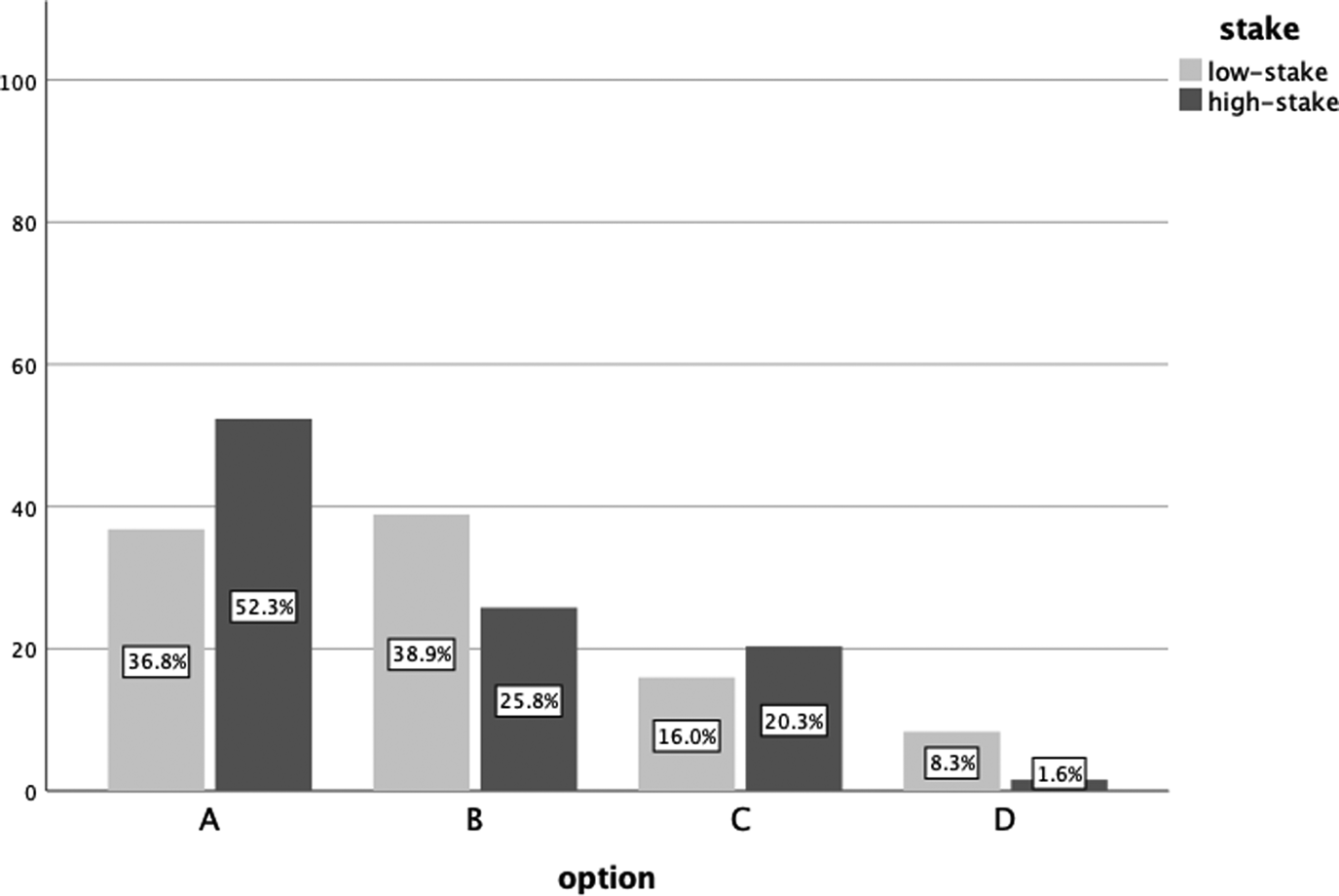
Figure 1. The percentages of each option across the three pairs of cases under low-stake and high-stake conditions in Experiment 1.
The Chi-square test indicated significant differences in response option proportions compared to chance rates in both low-stake (χ2 = 39.833, p < 0.001) and high-stake conditions (χ2 = 67.563, p < 0.001). Additionally, a significant difference appeared between participants' judgments under low-stake and high-stake conditions (χ2 = 14.011, p = 0.003). Further analysis also revealed significant differences in participants' choices of options A, B, and C between low-stake and high-stake conditions. Similar trends, though not significant according to Fisher's exact test (Bank: p = 0.219; Airport: p = 0.154; Spelling: p = 0.117), emerged in each pair of cases, with a greater proportion of option A under high-stake conditions and greater proportions of options B and D under low-stake conditions (see Table 2).Footnote 6
Table 2. The counts and percentages of each option under low-stake and high-stake conditions in each pair of cases in Experiment 1

3.3.2. Stake-effects on judgments about knowledge
To detect whether participants' judgments about knowledge were sensitive to stakes, options A and B were combined, as well as options C and D. Participants who chose option A or B were taken as willing to attribute knowledge to the protagonists, while participants who chose option C or D were taken as unwilling to attribute knowledge to the protagonists.
It turned out that stakes did not significantly affect participants' judgments about knowledge (see Figure 2 and Table 3). The combined proportion of options A and B was 75.7% under low-stake conditions, and 78.1% under high-stake conditions. Participants were more likely to choose option A or B than option C or D, regardless of whether the stakes were low or high. And the combined proportions of options A and B were significantly more than 50% under both conditions (Low-stake: χ2 = 38.028, p < 0.001; High-stake: χ2 = 40.500, p < 0.001).
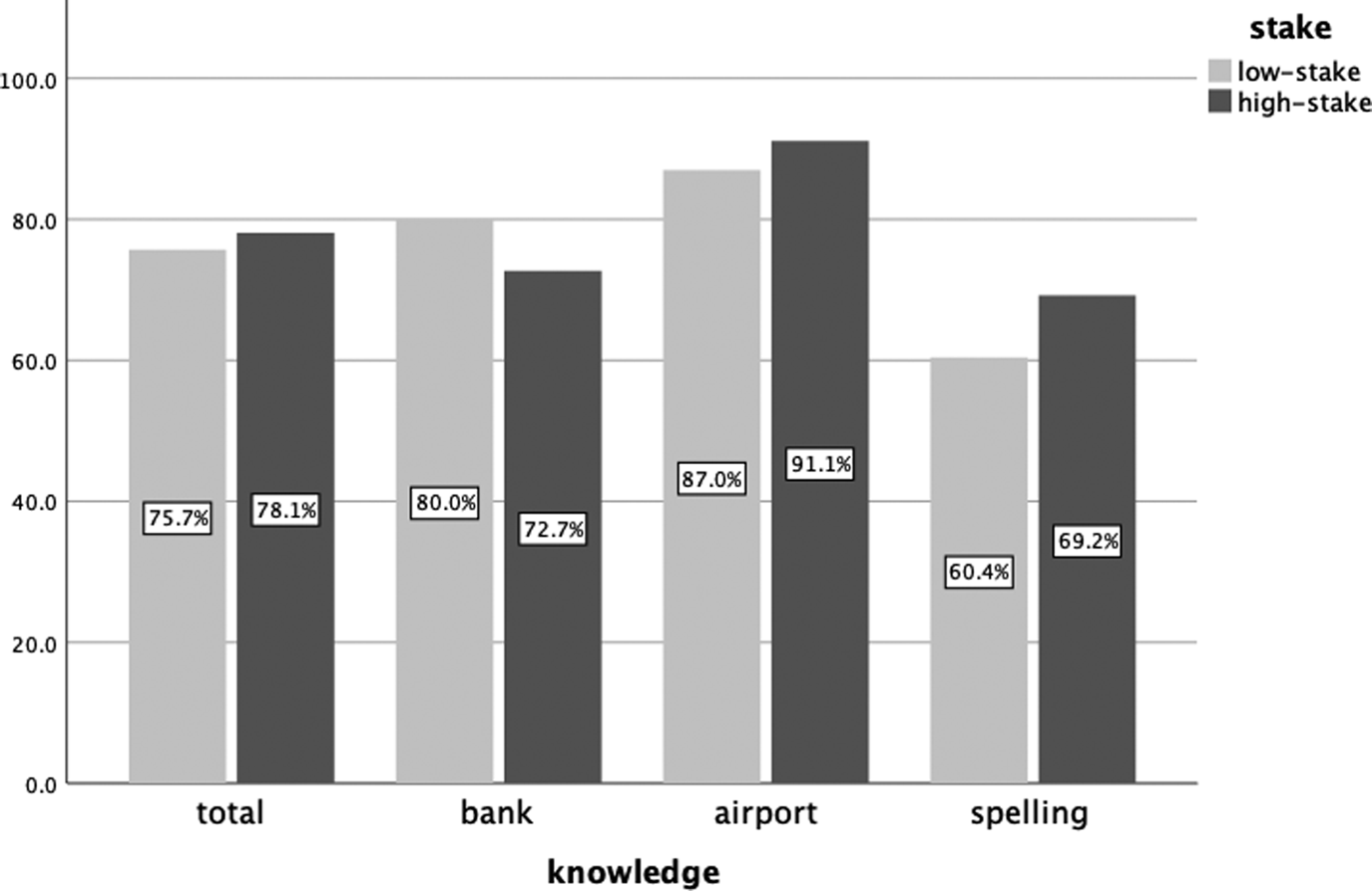
Figure 2. The combined percentages of options A&B under low-stake and high-stake conditions in total and each pair of cases in Experiment 1.
Table 3. The combined counts and percentages of options A&B and options C&D under low-stake and high-stake conditions in total and each pair of cases in Experiment 1
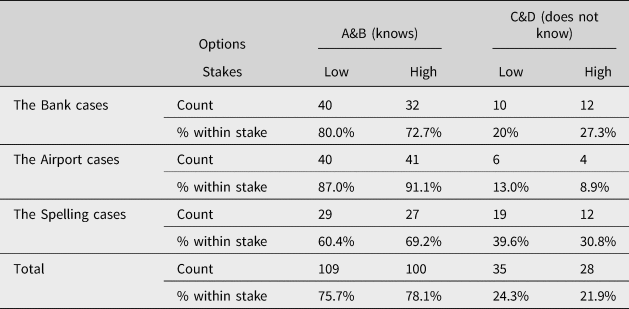
The Chi-square analysis revealed no significant effect of stakes on the inclination to knowledge attribution (χ2 = 0.225, p = 0.635), which replicated the results of most previous empirical studies. In every pair of cases, similar trends emerged, with no significant differences in inclination to knowledge attribution under low-stake and high-stake conditions in any of them (Bank: χ2 = 0.691, p = 0.406; Airport: according to Fisher's exact test, p = 0.739; Spelling: χ2 = 0.729, p = 0.393).Footnote 7
3.3.3. Stake-effects on judgments about action
To detect whether participants' judgments about action were sensitive to stakes, options A and C were combined, as well as options B and D. Participants who chose A or C were taken as unsatisfied with the protagonists' epistemic position for corresponding actions while participants who chose option B or D were taken as satisfied with the protagonists' epistemic position for corresponding actions.
The results illustrated that stakes strongly affected participants' judgments about action (see Figure 3 and Table 4). Under low-stake conditions, the combined proportion of options A and C was 52.8%, which did not significantly deviate from the chance rate (χ2 = 0.444, p = 0.505). While under high-stake conditions, this proportion increased to 72.7%, significantly exceeding 50% (χ2 = 26.281, p < 0.001).
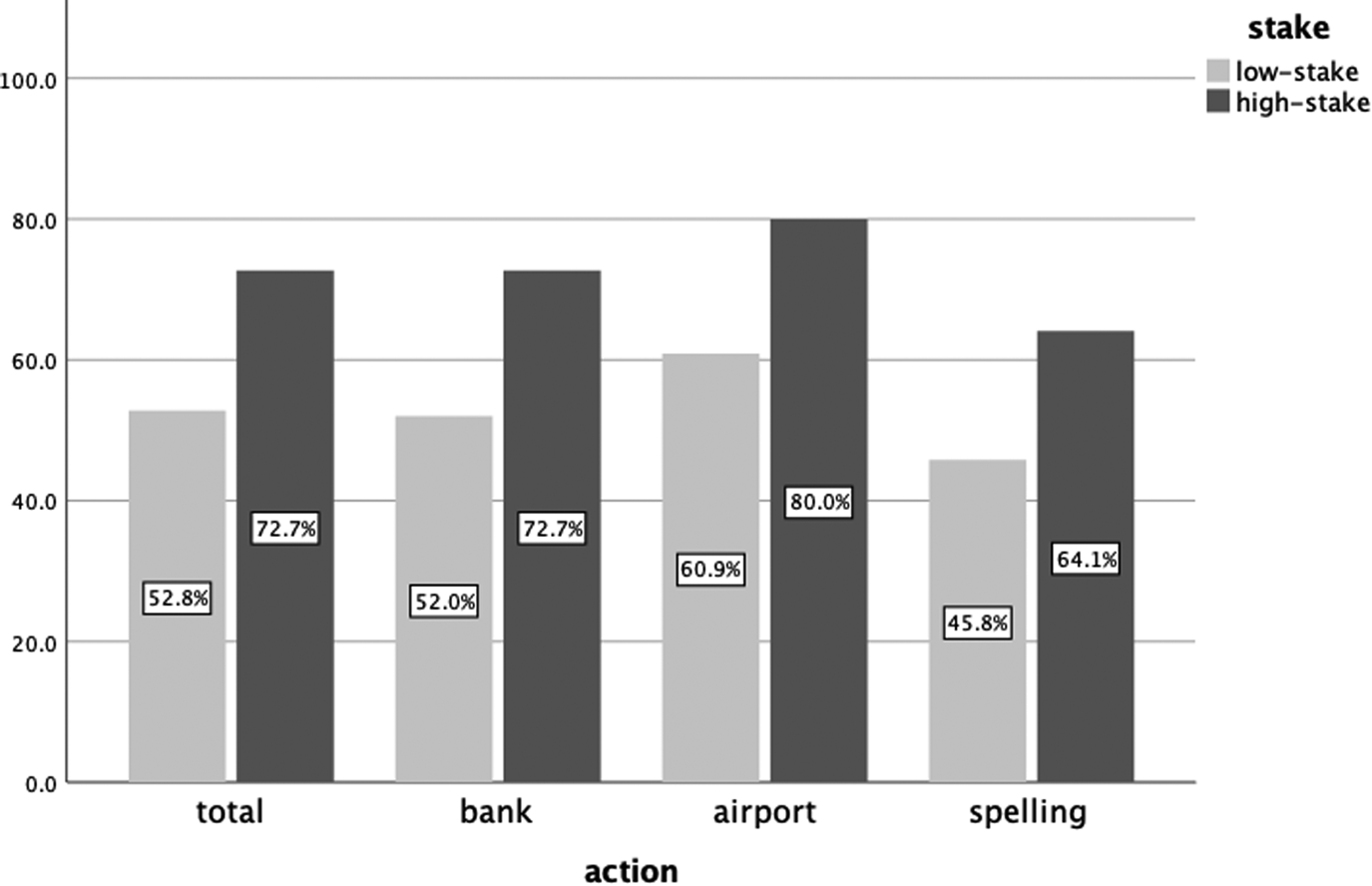
Figure 3. The combined percentages of options A&C under low-stake and high-stake conditions in total and each pair of cases in Experiment 1.
Table 4. The combined counts and percentages of options A&C and options B&D under low-stake and high-stake conditions in total and each pair of cases in Experiment 1
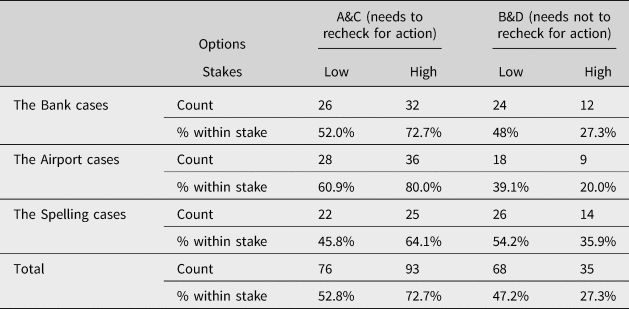
Moreover, the Chi-square test revealed a significant effect of stakes on judgments about related actions (χ2 = 11.381, p = 0.001). Participants were more inclined to choose option A or C under high-stake conditions than low-stake conditions. In other words, the requirements for related action were adjusted without modification in the standards of knowledge in high-stake cases. Further analysis showed similar trends across cases, with either significant or marginal significant differences in judgments about action (Bank: χ2 = 4.255, p = 0.039; Airport: χ2 = 3.989, p = 0.046; Spelling: χ2 = 2.891, p = 0.089).Footnote 8
3.4. Discussion
The results of Experiment 1 showed the influences of stakes on participants' choice of the four response options. Under high-stake conditions, option A had the highest proportion, and this proportion was significantly greater than its counterpart under low-stake conditions. However, option B emerged as the predominant choice under low-stake conditions, with its proportion significantly higher than under high-stake conditions. In other words, most participants thought the protagonists had knowledge under both conditions, but they felt a greater need to double-check before taking action when the stakes were high. The results suggested that stakes affected how much further effort was required for certain actions but did not affect the conditions for knowledge attribution.
Subsequent analysis using combined options further confirmed the distinct effects of stakes on judgments about knowledge and actions. The combined proportion of options A and B illustrated that the standards for knowing remained insensitive to the stakes change. The majority of the participants agreed that the protagonists had knowledge, regardless of low or high stakes. In contrast, the combined proportion of options A and C implied that the necessity for double-checking before taking certain actions was highly affected by stakes. Significant more participants thought that the protagonists needed to reconfirm their information for actions under high-stake conditions than under low-stake conditions.
In summary, participants' judgments about knowledge were not sensitive to stakes while their judgments about action were. This divergence in patterns between judgments about knowledge and action in response to stakes contradicted pragmatic encroachment's claims about the sensitivity of knowledge attribution as well as the relation between knowledge and action.
4. Experiment 2
Concerns were raised regarding the phrasing of options in Experiment 1, as it might have made it too easy for participants to ignore the tension between knowledge and failure to act accordingly. In the Bank cases, the protagonist might know the bank is open on Saturday but not the exact opening hour. In the Airport cases, the protagonist might know the fight is direct but lacks other flight information. In the Spelling cases, the protagonist might know there is no typo but still needs to review for writing improvement. If the further efforts required in high-stake cases were based on these considerations, the result of Experiment 1 would not be able to challenge pragmatic encroachment.
Therefore, Experiment 2 was conducted to determine if the nonparallel pattern of the judgments about knowledge and action illustrated in Experiment 1 was due to the prompts. Experiment 2 remained most design from Experiment 1 except for the options. For instance, in the Bank cases, option A was changed from “John knows the bank is open on Saturday. It is necessary for John to check the opening hour of the bank before going home” to “John knows the bank is open on Saturday. It is necessary for John to check whether the bank is open on Saturday before going home.” This modification aimed to exclude the possibility that it is the need for some other information precludes the protagonist from acting on his knowledge.
4.1. Participants
Four hundred two questionnaires were collected in total, and 272 were deemed effective, with a retrial rate of 67.7% (23.9% were excluded due to incorrect responses to comprehension questions, and 8.5% were excluded due to their possession of at least one degree in philosophy). The effective sample ranged from 18 to 62 years old (M = 30.62, SD = 7.50), with females comprising 65.1%.Footnote 9 The experiments were conducted via the online survey platform Wenjuanxing (http://www.wjx.cn), with all materials delivered in Chinese. The questionnaire took an average of 3 minutes to complete. Repeat participation was prevented through IP. Participants of Experiment 1 were also prevented through IP. A comprehensive dataset is accessible in supplementary materials provided on CJO.
4.2. Materials and design
Experiment 2 took the same materials and between-subject design as Experiment 1. The only difference was that, after reading the materials, participants needed to choose the best description of the protagonists' situation from four modified options. Take the Bank cases for example again, the four modified options were as follows:
A. John knows the bank is open on Saturday. It is necessary for John to check whether the bank is open on Saturday before going home.
B. John knows the bank is open on Saturday. It is not necessary for John to check whether the bank is open on Saturday before going home.
C. John does not know if the bank is open on Saturday. It is necessary for John to check whether the bank is open on Saturday before going home.
D. John does not know if the bank is open on Saturday. It is not necessary for John to check whether the bank is open on Saturday before going home.
If participants in Experiment 1 chose option A because they thought the protagonist needed extra information about the opening hour, besides whether the bank is open on Saturday, a significant decline in the proportion of option A would be expected in Experiment 2. Nevertheless, if a considerable number of participants still preferred option A in Experiment 2, it would imply that the results of Experiment 1 were not solely due to the possible ambiguity of the options but rather reflected a diverge in the understanding of the relation between knowledge and action between folks and pragmatic encroachers.
Afterward, participants were required to answer the same comprehension questions as in Experiment 1. Participants who failed to answer these questions were also excluded.
4.3. Result
4.3.1. Stake-effects on four response options
Stake-effects on participants' choices of the four response options were also significant in Experiment 2. The percentages of the four response options in low-stake and high-stake conditions are presented in Figure 4. (Low-stake: A: 26.6%, B: 46.1%, C: 21.1%, D: 6.3%; High-stake: A: 54.2%, B: 24.3%, C: 18.8%, D: 2.8%):
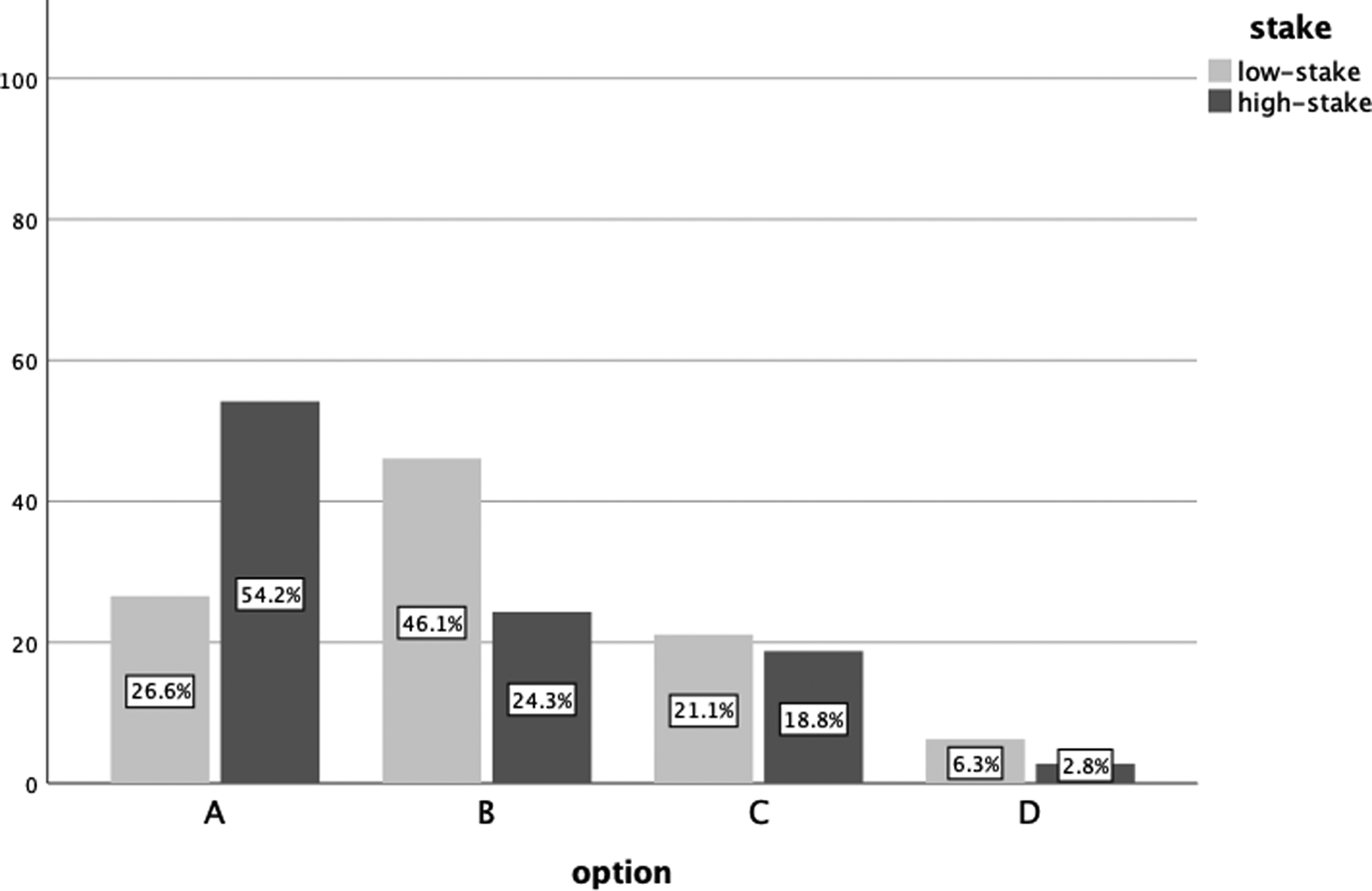
Figure 4. The percentages of each option across the three pairs of cases under low-stake and high-stake conditions in Experiment 2.
The Chi-square test unveiled significant differences in response option proportions compared to chance rates in both low-stake (χ2 = 41.688, p < 0.001) and high-stake (χ2 = 79.722, p < 0.001). A significant difference also appeared between participants' judgments under low-stake and high-stake conditions (χ2 = 23.888, p < 0.001). Subsequent analysis revealed that the participants' choices of options A and B significantly differed under low-stake and high-stake conditions. The results across each pair of cases showed consistent trends. Fisher's exact test exhibited significant differences in the Bank cases (p = 0.029) and Spelling cases (p = 0.001), with marginally significant differences in the Airport cases (p = 0.068). Further analysis indicated significantly greater proportions of option B under low-stake conditions in the Bank cases and Spelling cases, and significantly greater proportions of option A under high-stake conditions in the Airport cases and Spelling cases (see Table 5).Footnote 10
Table 5. The counts and percentages of each option under low-stake and high-stake conditions in each pair of cases in Experiment 2

4.3.2. Stake-effects on judgments about knowledge
Experiment 2 failed to find any stake-effect on judgments about knowledge either (see Figure 5 and Table 6). In Experiment 2, the combined proportion of options A and B was 72.7% under the low-stake condition, and 78.5% under the high-stake condition. Participants favored option A or B over option C or D, no matter under low-stake or high-stake conditions. And combined proportions of options A and B were significantly above the chance rates in both conditions (Low-stake: χ2 = 26.281, p < 0.001; High-stake: χ2 = 46.694, p < 0.001).

Figure 5. The combined percentages of options A&B under low-stake and high-stake conditions in total and each pair of cases in Experiment 2.
Table 6. The combined counts and percentages of options A&B and options C&D under low-stake and high-stake conditions in total and each pair of cases in Experiment 2
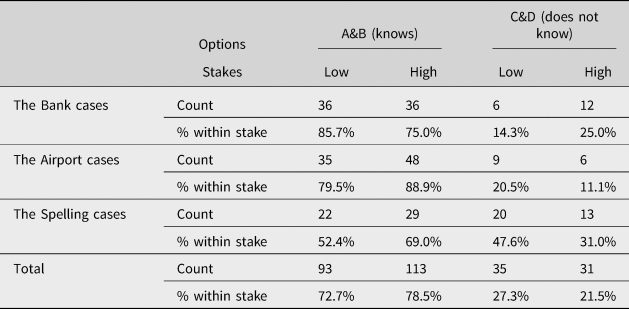
The Chi-square analysis revealed no significant effect of stakes on the inclination to knowledge attribution (χ2 = 1.247, p = 0.264), which replicated the results of Experiment 1. The effect of stakes failed to be found in each pair of cases either (Bank: χ2 = 1.607, p = 0.205; Airport: χ2 = 1.633, p = 0.201; Spelling: χ2 = 2.446, p = 0.118).Footnote 11
4.3.3. Stake-effects on judgments about action
Even with the modified options in Experiment 2, the stake-effects persisted (see Figure 6 and Table 7). Under low-stake conditions, the combined proportion of options A and C was 47.7%, which did not significantly deviate from the chance rate (χ2 = 0.281, p = 0.596). While under high-stake conditions, this proportion was 72.9%, significantly surpassing the 50% (χ2 = 30.250, p < 0.001).
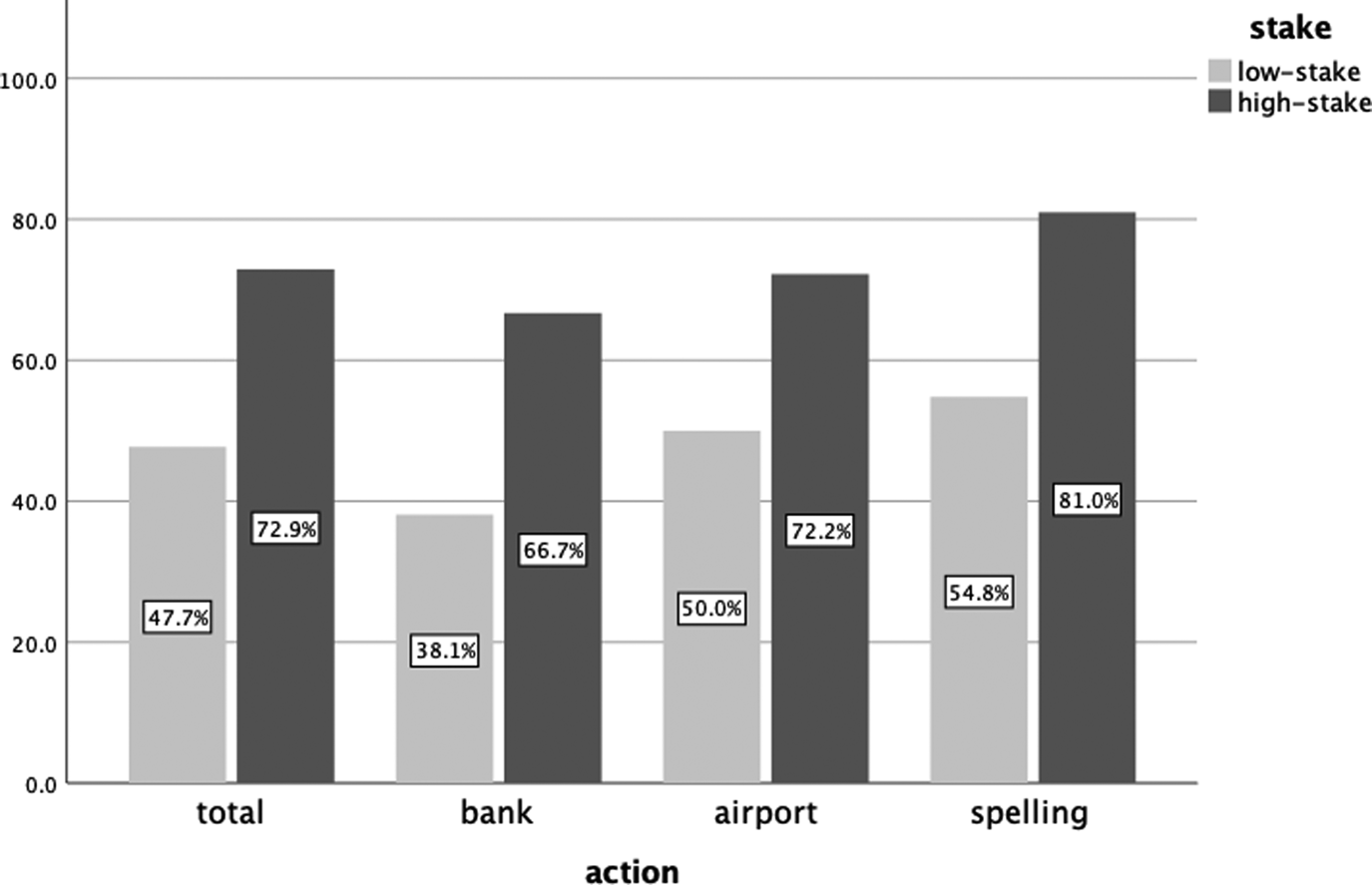
Figure 6. The combined percentages of options A&C under low-stake and high-stake conditions in total and each pair of cases in Experiment 2.
Table 7. The combined counts and percentages of options A&C and options B&D under low-stake and high-stake conditions in total and each pair of cases in Experiment 2
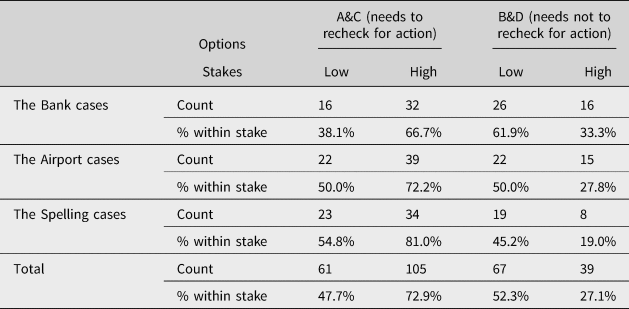
The Chi-square test indicated a significant difference in judgments about related actions between high-stake and low-stake conditions (χ2 = 18.181, p < 0.001). The combined proportion of options A and C was much greater under high-stake conditions than under low-stake conditions. This pattern held for each pair of cases, with significant differences in judgments about action observed (Bank: χ2 = 7.347, p = 0.007; Airport: χ2 = 5.095, p = 0.024; Spelling: χ2 = 6.604, p = 0.010).Footnote 12
4.4. Discussion
Experiment 2 basically replicated the results of Experiment 1, showing no apparent decrease in the proportion of option A. The dominant option under high-stake conditions was still option A, while the dominant option under the low-stake condition was still option B. The analysis of combined options also illustrated similar patterns to Experiment 1. Again, the experiments demonstrated that stakes only affect participants' judgments about action, but not on judgments about knowledge. Additionally, the modified options ruled out the possibility that the requirements for further reconfirmation under high-stake conditions were due to a need for additional information beyond what the protagonists already knew.
Overall, Experiment 2 reaffirmed the findings of Experiment 1, including the insensitivity of knowledge attributions to sakes and the insufficiency of knowledge for action, especially when stakes were high. Experiment 2 once again contradicted the pragmatic encroacher's expectation. Conversely, due to the modification of options, it provided more robust evidence in favor of purism.
5. Experiment 3
Nevertheless, some ambiguities of the results in experiments 1 and 2 still need to be clarified. Since most participants agreed with the necessity for reconfirming when the stakes were high, they might probably assume that the protagonists in high-stake conditions either had already double-checked or were prepared to do so as it was necessary. And it was this inference that made the protagonists be regarded as knowing. If this interpretation holds, the results of Experiments 1 and 2 may not support purism, for practical factors were considered in participants' knowledge attribution.
To assess the validity of this interpretation, Experiment 3 was conducted. Most of the materials and design of Experiments 1 and 2 remained, except that, in Experiment 3, participants were required to choose between two options. Take the Bank cases for example, participants needed to decide whether ‘John knows the bank is open on Saturday without checking the opening hour of the bank’ or ‘John does not know if the bank is open on Saturday without checking the opening hour of the bank’. This design aimed to determine if participants' knowledge attributions under high-stake conditions in the previous experiments were based on their presumption that protagonists had rechecked or were ready to recheck as a matter of necessity.
5.1. Participants
Four hundred fifty questionnaires were collected in total, and 346 were deemed effective, with a retrial rate of 76.9% (23.1% were excluded due to incorrect responses to comprehension questions. Participants with at least one degree in philosophy were prevented in advance by the platform). The effective sample ranged from 17 to 60 years old (M = 30.91, SD = 7.54), with females comprising 58.7%.Footnote 13 The experiments were conducted via the online survey platform Wenjuanxing (http://www.wjx.cn), with all materials delivered in Chinese. The questionnaire took an average of 2 minutes to complete. Repeat participation was prevented through IP. Participants of Experiment 1 and Experiment 2 were also prevented through IP. A comprehensive dataset is accessible in supplementary materials provided on CJO.
5.2. Materials and design
The materials in Experiment 3 were primarily the same as those in experiments 1 and 2 and took the same between-subject design. Minor modifications were made to the Bank cases to mitigate potential interference brought by phrasing. For example, the statement “in addition, he knows that the bank is closed on Sundays” was replaced with “in addition, the bank is closed on Sundays, and John is pretty clear about that,” to avoid using the term “know.” Additionally, the statement “John decides to go home and deposit money the following tomorrow (Saturday) morning” was modified into “John wonders if he should come back to the bank tomorrow (Saturday) morning to deposit money,” to prevent interference with participants' knowledge attributions arising from the protagonist's decision of action. There were no such phrasing issues in the Airport cases and the Spelling cases, therefore the materials of these two cases were identical to those in experiments 1 and 2.
After reading the material, participants needed to choose a statement that best described the protagonist’ situation. The two options in the Bank cases were as follows:
A. John knows the bank is open on Saturday without checking the opening hour of the bank.
B. John does not know if the bank is open on Saturday without checking the opening hour of the bank.
Suppose participants attributed knowledge in prior experiments under high-stake conditions because they thought protagonists had already rechecked or prepared to, there should be significantly less knowledge attribution under high-stake conditions than under low-stake conditions in Experiment 3. On the contrary, if there is no significant difference in knowledge attribution between high-stake and low-stake conditions, it would reinforce that ordinary people's standards of knowledge are not sensitive to practical considerations.
Participants were then presented with the same comprehension questions as in experiments 1 and 2, and those who answered incorrectly were excluded.
5.3. Results
Stake effects on participants' choices of the two response options were not significant in Experiment 3, with the proportion of option A (knows without checking) being 66.9% under low-stake conditions, and 67.2% under high-stake conditions. The percentages of the two response options are presented in Figure 7 and Table 8.
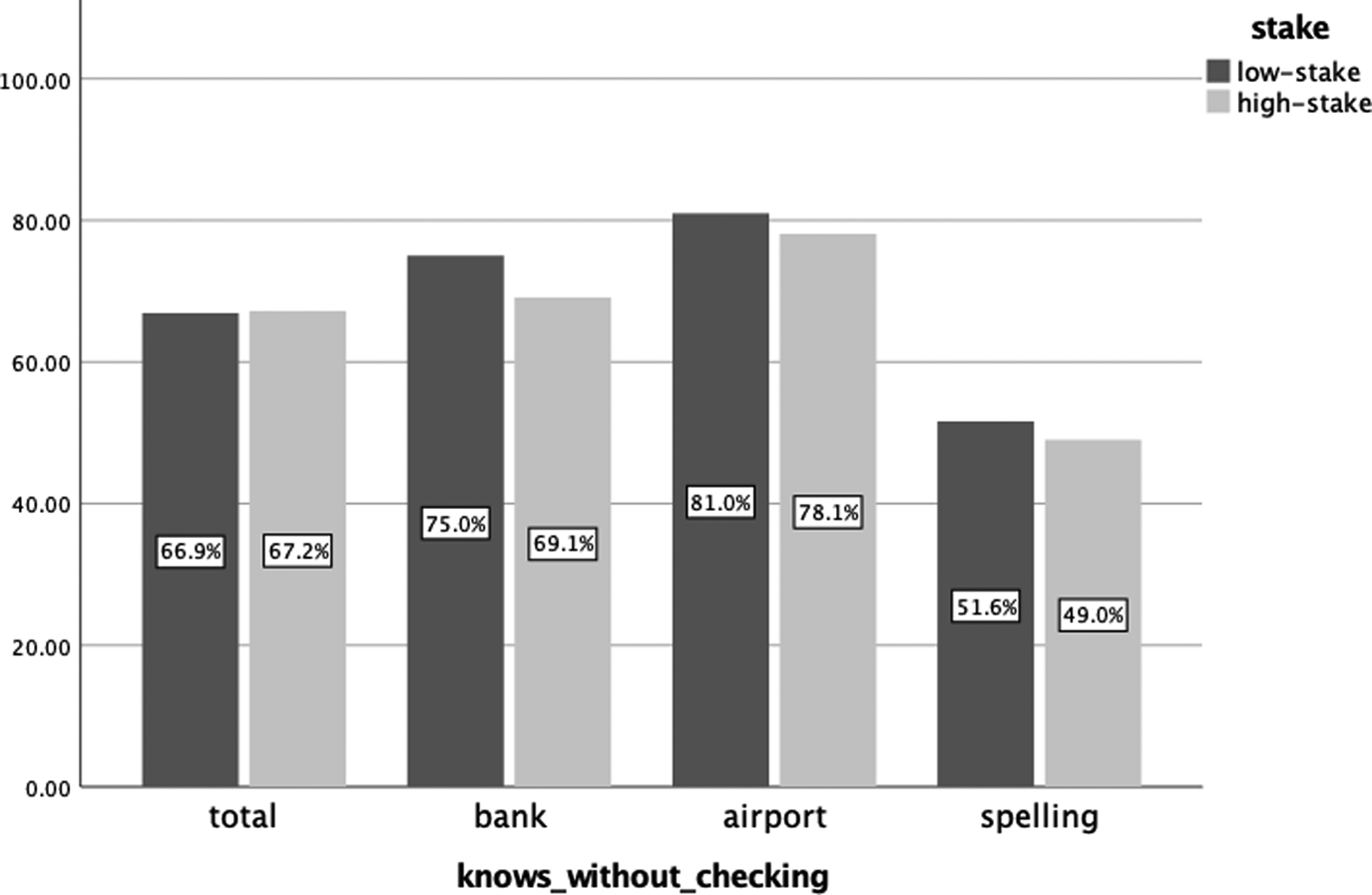
Figure 7. The percentages of option A (knows without checking) in total and each pair of cases in Experiment 3.
Table 8. The counts and percentages of each option under low-stake and high-stake conditions in total and each pair of cases in Experiment 3
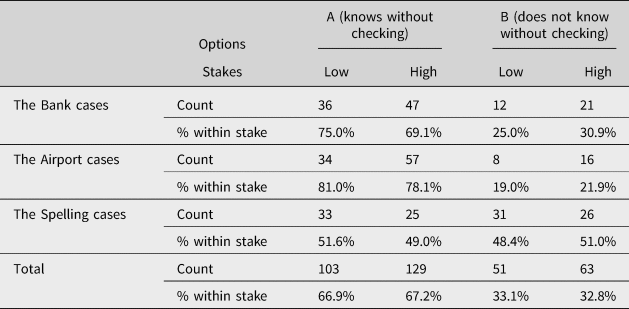
The Chi-square test indicated significant differences in response option proportions compared to chance rates in both low-stake (χ2 = 17.558, p < 0.001) and high-stake conditions (χ2 = 22.688, p < 0.001). And the Chi-square test revealed no significant difference between participants' judgments under low-stake and high-stake conditions (χ2 = 0.004, p = 0.952). The effect of stakes failed to be found in each pair of cases either (Bank: χ2 = 0.478, p = 0.489; Airport: χ2 = 0.133, p = 0.715; Spelling: χ2 = 0.073, p = 0.786).Footnote 14
5.4. Discussion
Once more, in Experiment 3, the stake effect on knowledge attribution was not observed. The percentage of participants who chose option A under high-stake conditions was not significantly different from that under low-stake conditions. Even without checking, protagonists were no less likely to be regarded as knowing under high-stake conditions than under low-stake conditions. According to the results, the interpretation that participants attributed knowledge to protagonists under high-stake conditions due to the presumption of protagonists having rechecked or being prepared to recheck no longer seems plausible.
In summary, Experiment 3 verified the conclusions drawn from experiments 1 and 2. Participants' propensity for knowledge attribution was not affected by stakes. Moreover, the results clarified that attributing knowledge to protagonists under high-stake conditions might not stem from the belief that protagonists should have checked and, therefore, had done so. Instead, it suggests that, according to folks, protagonists in high-stake situations may not have needed more checks than those in low-stake situations to be deemed as knowing.
6. General discussion
Now we can return to the two core concerns around knowledge attribution cases: are ordinary people's judgments about knowledge indeed sensitive to stakes, and does pragmatic encroachment provide the sole or best explanation for this sensitivity? According to the three experiments, both questions seem to yield negative responses. On the one hand, participants' standards of knowledge remain steady despite varying stakes. On the other, the anticipated parallel pattern of the judgments about knowledge and action, foundational to pragmatic encroachers' explanation, failed to be found. If the results are reliable, it is reasonable to consider that ordinary people lean more toward purism rather than pragmatic encroachment, and the relation between judgments about knowledge and action is more likely to be pragmatic.
6.1. Ordinary people as purist and moderate invariantism
The three experiments together suggest that ordinary people apply different standards to knowledge and action, with only the standards of action responding to stakes while the standards of knowledge do not. This aligns cohesively with previous studies on knowledge attribution and stakes, which also indicate that the usage of knowledge and associated concepts in everyday talks is unaffected by stakes. Therefore, it is plausible to cast doubt on the stake-sensitive use of knowledge that pragmatic encroachers attempt to explain.
A straightforward response from pragmatic encroachers could be that the sensitivity to practical factors might be easier to find in other cases. While purism aims to exclude practical considerations from knowledge judgments entirely, pragmatic encroachers only need to identify a few cases where stakes influence knowledge judgments to challenge purism. Conversely, the absence of stake effects in a few cases does not necessarily pose a threat to pragmatic encroachment in the same way.
However, the cases in this study were not randomly chosen. They were cases even pragmatic encroachers themselves frequently cited in their defense (Pinillos Reference Pinillos, Brown and Gerken2012; Pinillos and Simpson Reference Pinillos, Simpson and Beebe2014; Sripada and Stanley Reference Sripada and Stanley2012; Stanley Reference Stanley2005). Therefore, it is reasonable to assume that these were cases expected to be the most susceptible to detecting stake effects by pragmatic encroachers, otherwise, they might just have appealed to others. In other words, it was within cases that pragmatic encroachers believed to have the best chance so far where the stake sensitivity was not discovered. While it remains an open question whether there could be cases that better illustrate pragmatic encroachment, the failure to detect stake sensitivity in cases pragmatic encroacher once relied on does indeed present a challenge to their position. And that's why the findings of this study can raise questions about the likelihood that folks are with pragmatic encroachment.
Nevertheless, although ordinary people exhibit a purist tendency for their stake-insensitive judgments about knowledge, the folk's purism obviously diverges from the Cartesian's, which requires absolute certainty for knowledge. Conversely, the epistemic requirement for ordinary people to acknowledge knowledge appears undemanding, as it can be easily satisfied under high-stake and low-stake conditions. Most participants were willing to attribute knowledge even when the protagonists' beliefs would lead to extremely disastrous consequences once got wrong. This inclination suggests that folk epistemology may tend toward a version of moderate invariantism. In other words, ordinary people seem to hold a standard of knowledge that is easy to reach and insensitive to practical factors.
Meanwhile, these findings also prompt new questions for further investigation, such as the epistemic standards for taking action. The non-covariation between judgments about knowledge and action in cases with different stakes suggests occasional divergence in folks' epistemic requirements for acting as opposed to knowledge. Specifically, participants were inclined to suggest the protagonists should seek more evidence before taking action even if they thought the protagonists had knowledge, particularly when the stakes were high.
Given this observed divergence between the standards of knowledge and action in folk epistemology as revealed in these findings, it would be highly interesting to explore the circumstances under which this divergence occurs and the factors that might mediate it. According to the experiments, stakes emerged as a factor that significantly impacted folks' judgments about whether the protagonists could take actions based on their knowledge. Yet what other factors, aside from stakes, could potentially contribute to such discrepancies? Moreover, does action commonly require more than knowledge, or might some practical factors, such as urgency, allow people to take action even when they don't meet the requirement for knowing? These are questions warranting further investigation. While knowledge has long been the focus of folk epistemology, the epistemic standards for action, which equally play essential roles in our daily lives, also merit exploration.
To summarize, the experiments suggest that practical factors such as stakes might not be prominently considered in folk judgments about knowledge. And given their propensity for generous knowledge attribution across varying stakes, ordinary people seem inclined toward a form of purism with moderate standards of knowledge. Moreover, the divergent standards between knowledge and action observed in this study invite further exploration of epistemic norms for action.
6.2. A conversation-implicature explanation of the relation between knowledge and action
Given that the experiments provide unfavorable results to the pragmatic encroachment on both core concerns, one problem remains. That is how purism can account for the positive results from previous experiments with the evidence-seeking paradigm. Earlier discussions on this challenge suggested a conversation-implicature explanation, and participants' responses in this study offer some empirical support to this pragmatics approach.
As previously mentioned, studies employing the evidence-seeking paradigm constantly indicated that participants thought protagonists in high-stake situations needed to exert greater effort to be regarded as knowing, compared to those in low-stake situations (Pinillos Reference Pinillos, Brown and Gerken2012; Pinillos and Simpson Reference Pinillos, Simpson and Beebe2014; Sripada and Stanley Reference Sripada and Stanley2012). To account for these findings within the framework of purism, it was argued that prompts in the evidence-seeking paradigm might direct participants' attention to action rather than knowledge (Gerken Reference Gerken2017). Therefore, participants' responses might primarily reflect their assessments of how much evidence was needed for action instead of knowledge. And the observed stake sensitivity should be attributed to the influences of practical factors on action.
This “Epistemic Actionability-Proxy” explanation appealed to the confusion between questions about knowledge and action in the evidence-seeking paradigm. However, pragmatic encroachers may raise concerns about how a question about knowledge can possibly be misunderstood as a question about action if ordinary people do not consider knowledge sufficient for actions in the way pragmatic encroachers stated. Can there be other interpretations without appeal to pragmatic encroachment that might explain this confusion?
One alternative could be the conversation-implicature explanation of the relation between knowledge and action. In everyday conversations, knowledge assertions commonly serve as suggestions, recommendations, and commitments, indicating a propensity toward corresponding actions. Therefore, when the stakes were high, participants might hesitate to attribute knowledge to avoid being misinterpreted as an approval of taking related actions right away. And these pragmatic considerations may sometimes indirectly influence responses about knowledge by mediating the evaluations of actions. However, the meaning concerned action arising in knowledge claims was only implied instead of entailed.
In fact, this conversation-implicature explanation has gained attention among both purists (Gerken Reference Gerken2017) and pragmatic encroachers (Fantl and McGrath Reference Fantl and McGrath2007). And both camps invoked Grice's theory of cancellability to support their respective positions. According to Grice, one salient characteristic of conversational implicature, which refers to the implied meaning that arises in conversational contexts, resides in its “cancellability.” This means that it can be canceled in certain circumstances without rendering the statements unintelligible or unacceptable. Unsurprisingly, purists assert that the cancellability of action-related meaning in knowledge claims is intuitive while pragmatic encroachers contend that such cancellability is impossible.Footnote 15
It's important to note that empirical support is rarely available for either side of this debate. However, the experiments in this study bring some new evidence in support of this conversation-implicature explanation. In both Experiments 1 and 2, option A, which with the pattern “S knows p and it is necessary for S to reconfirm p before taking action,” could function as a test of cancelability. If S knows p entails that S can just act based on p, then option A would be an improbable choice due to its contradictory and nonsensical nature. In contrast, if S knows p only implies that S can act based on p in some conversational contexts, option A would present a coherent and reasonable choice, and it would likely be selected.
Despite the potential oddity it might pose to some philosophers, option A appeared to make sense to a considerable portion of participants, as evidenced by the percentages choosing it (44.2% in Experiment 1 and 41.2% in Experiment 2, both significantly surpassing the chance rates of 25%). This suggests that, at least in Chinese, claiming someone knows something but cannot act on it, might not necessarily raise substantial difficulty in understanding as pragmatic encroachers initially anticipated. In other words, the meaning related to actions in statements about knowledge appears to be cancellable for many ordinary people, indicating it might be just conversational implicature rather than entailment.
In brief, the findings in evidence-seeking experiments, typically cited in support of the pragmatic encroachment, may also find a plausible explanation within purism. The explanation draws upon the Gricean conversation-implicature theory and is supported by empirical evidence obtained in this study.
6.3. Possible criticizes and responses
Though the experiments suggest that the folk's understanding of the relation between knowledge and action is more akin to purism, in the sense that stakes are only considered in judgments about action but not in judgments of knowledge, a pertinent query may arise concerning the impact of experimental design on the observed divergence. In experiments 1 and 2, participants were asked to make judgments about both knowledge and action at the same time. This could potentially imply that distinct knowledge and action should be assessed based on distinct considerations, otherwise there would be no need to make two decisions.
However, this design itself cannot fully explain why participants were significantly more likely to choose A under high-stake conditions but B under low-stake conditions in experiments 1 and 2. If this preference for options reflecting a detachment between knowledge and action were solely an outcome of the presentation, comparable percentages of participants who chose these options should emerge across conditions. According to these findings, it is plausible to infer that the change in judgments about action was partially caused by stake, while the judgments about knowledge were not affected similarly.
Additionally, skepticism might arise among philosophers regarding the pertinence of experiments like these, which investigated the views of ordinary people lacking systematic training in philosophy, to contribute meaningfully to the philosophical debate between purism and pragmatic encroachment. Like many theories in philosophy, pragmatic encroachment was also motivated by its philosophical interest, aiming to offer a normative view of the relation between knowledge and action. Therefore, their partial apprehension of ordinary people's understanding of knowledge and action is not necessarily a fatal problem to pragmatic encroachment, since there is no reason to think that folk epistemology possesses conclusive authority in epistemology.
Nevertheless, pragmatic encroachers indeed appeal to the intuitions of those knowledge attribution cases and the use of knowledge in our ordinary language. This infers pragmatic encroachers perceive the explanation-power of these phenomena in our daily lives as advantages, and once attempted to prove their possession of such advantages. The experiments do not intend to conclusively refute pragmatic encroachment or deny its possibility to be saved by further philosophical considerations. However, the results at least pointed out that ordinary people's views they previously thought supported them might not entirely align with them.
7. Conclusion
To determine whether purism or pragmatic encroachment can gain support from the folk's understanding of the relation between knowledge and action, this study conducted three experiments based on three classic pairs of knowledge attribution cases and asked participants to make judgments about knowledge and action simultaneously in two of them. It appears that, from ordinary people's perspective, knowledge may sometimes not be taken as a sufficient epistemic condition for action. Meanwhile, practical factors such as stakes seem to only influence judgments about action but not knowledge. This suggests that ordinary people might potentially align more with purists than pragmatic encroachers.
Of course, there are some obvious limitations in this study. First, the experiments were only based on questionnaires, where participants might withdraw their genuine views, and did not offer direct tests of real-world behavior. Future investigation will employ more paradigms from psychological and behavioral economics, which have been increasingly integrated into experimental philosophy (Fischer and Engelhardt Reference Fischer, Engelhardt, Curtis, Eugen and Fischer2019; Francis et al. Reference Francis, Terbeck, Briazu, Haines, Gummerum, Ganis and Howard2017; Hansen et al. Reference Hansen, Porter and Francis2019), to better comprehend folk's understanding of knowledge and action. For example, by adopting techniques like reaction time measurement and eye-tracking, one may uncover temporal dynamics and cognitive engagement when participants read sentences with knowledge-action conflicts. And these approaches yield data less prone to participants' manipulation. Likewise, utilizing corpus-based research about the frequency of expressions with the pattern that someone knows something but can still not act accordingly, may shed light on the diverge between standards of knowledge and action in ordinary language. Moreover, leveraging immersive virtual reality scenarios to prompt decisions, like determining whether they should seek more evidence or act immediately, can help unveil judgments closer to those ordinary people may make in real-life contexts.
Another limitation of this study lies in its exclusive reliance on Chinese participants. Chinese philosophy has long been concerned with the issue of knowledge and action, and likely cast an influence on contemporary perspectives. This traditional imprint might more or less affect participants' responses in the experiments, rendering the findings culture specific. Consequently, the applicability of these findings to explain the outcomes of prior experiments involving Western participants awaits confirmation through subsequent cross-cultural investigations.Footnote 16
Supplementary material
The supplementary material for this article can be found at https://doi.org/10.1017/epi.2023.56.

















